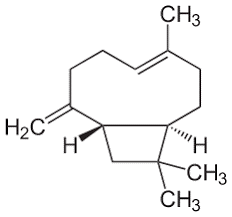BRAZIL: A COUNTRY OF DIVERSE AND REMARKABLE AROMATIC TREASURES,
INCLUDING COPAIBA OLEORESIN AND ESSENTIAL OIL
By Rhiannon Lewis, Director of Essential Oil Resource Consultants,
Editor of "The International Journal of Clinical Aromatherapy" & Host of "Botanica" Events

The following content is intended for information purposes only. Before use, we recommend seeking the advice of a health professional specialized in aromatherapy and cannot be held responsible if taken without prior medical advice.
"In my role as aromatherapy educator, I have had the joy of visiting Brazil on several occasions and always come away inspired and enthused by the diversity of this country’s aromatic treasures as well as the knowledge and skills of Brazilian aromatherapy practitioners. Whilst Brazil offers a wide range of remarkable medicinal plants, vegetable oils, and essential oils, in terms of the latter, I have a personal favorite, that I predicted 6 years ago would deliver a major contribution to the aromatherapy world: Copaiba. Of particular interest to me was its level of ß-caryophyllene; a component with a wide range of positive actions and a healthy safety profile.
ß-CARYOPHYLLENE
The bicyclic sesquiterpene ß-caryophyllene has received much research interest in recent years as it demonstrates an increasingly wide range of health-enhancing and health-protective properties. A major sesquiterpene component found in a large number of essential oils, it is especially concentrated (above 10%) in a number of essential oils that are commonly used in clinical aromatherapy, including:
- Copaifera officinalis 41-66%
- Ocimum sanctum 29-37%
- Piper nigrum 14-27%
- Melissa officinalis 10-25%
- Cananga odorata 12-15%
- Achillea millefolium 10-15%
- Humulus lupulus up to 15%
- Cannabis sativum up to 18%

Several important reviews (Machado et al, 2018 ; Sharma et al, 2016; Fidyt et al, 2016; Francomano et al, 2019) have confirmed the wide range of potential health benefits this component may offer, including:
- Antioxidant
- Anticonvulsant
- Anti-inflammatory
- Myorelaxant
- Cardioprotective
- Neuroprotective
- Gastro & hepatoprotective
- Nephroprotective
- Antimicrobial
- Immune modulatory
- Local anaesthetic
- Antineuralgic
- Analgesic
- Cytoprotective
- Anxiolytic
- Wound healing
Largely due to its antioxidant and anti-inflammatory effects, ß-caryophyllene has been proposed as a potential protective component for a number of disorders such as pain, anxiety, spasm, depression as well as neurodegenerative diseases such as Alzheimer’s disease, multiple sclerosis, Parkinson’s disease, stroke, amyotrophic lateral sclerosis and cerebral ischaemia.
Many of the more recent studies have arisen due to its presence as one of the main terpenes found in cannabis extracts and the fact that is a selective full agonist of CB2 receptors, activating the endocannabinoid system. These particular cannabinoid (CB2) receptors are involved in the modulation of pain and inflammation and are also involved in neuroprotection. Whilst this is not the only mechanism of action of ß-caryophyllene, the popularity of cannabis extracts has led to a boom in phytocannabinoid research.
The terpene cannabinoids in Cannabis sativa are mainly natural non-selective ligands for CB1 and CB2 receptors. In the case of ß-caryophyllene, this phytocannabinoid component is selective of the CB2 receptor only. This means that it does not have the psychomodulatory/ psychogenic effects typically seen with cannabis products.
Safety
In terms of toxicity, Tisserand and Young (2013) state that ß-caryophyllene is a weak skin allergen, non-toxic, non-mutagenic and antitumoral (page 520-521). It is approved as a food additive and flavouring agent.
Drug: essential oil interactions: none known.
COPAIFERA / COPAIBA
There are over 50 species of the tropical Copaifera genus (member of the Fabaceae family) with three in particular being exploited for their oleoresin on a large scale:
- Copaifera langsdorfii
- Copaifera officinalis
- Copaifera reticulata
The main country of origin for the oleoresin and essential oil is Brazil (in particular the Amazon region) but Copaifera species distribution is wide across South America as well as West Africa. The name copaiba originates from an indigenous Amazonian language (tupi) cupa-yba to denote reservoir/vessel with reference to its store of oleoresin in the trunk.
The oleoresin of these trees is extracted through tapping and the oleoresin is used therapeutically in its raw state or distilled to yield copaiba essential oil.
The traditional uses of copaiba oleoresin in the Brazilian Amazon include wound and ulcer healing, antimicrobial and anti-inflammatory properties for skin diseases as well as for relief of rheumatic diseases. The oleoresin is used pure or diluted 1:5 or 1:10 with other bases.
The oleoresin and the essential oil are both rich in a range of sesquiterpenes such as ß -caryophyllene, bisabolene and alpha-copaene. The oleoresin is also an important source of diterpenic acids such as kaurenoic acid and copalic acid – rarely present in the essential oil due to their poor volatility. These acids have therapeutic activity and are particularly cited for their antiparasitic, antimicrobial, insecticidal and anti-inflammatory properties.
COPAIBA ESSENTIAL OIL
The distilled essential oil rather than the oleoresin is what I have most experience of in its applications.
A typical composition shows the essential oil being dominated by a large number of sesquiterpenes (over 90% of the total oil) with ß-caryophyllene typically being over 50%. Other main sesquiterpenes include humulene (alpha-caryophyllene), ß-elemene, Germacrene D and a-copaene. Very small to trace amounts of diterpenes are present due to their low volatility (compare to the crude oleoresin).
Uses
The essential oil is easy to use, with its mild aroma, gentle action and absence of toxicity (Tisserand & Young : no known hazards or contraindications). It blends readily with other essential oils, adding a base note stabilization to the blend.
- Topically, it may reduce pain and inflammation and promote tissue repair.
- Inhaled, it instils a sense of calmness, grounding and is soothing to respiratory passages.
- It may also be used in mouth rinses for sore throat and gums (swish and spit oral rinsing).
- In cancer care, it is one of the essential oils that I include in a blend for reducing symptoms of peripheral neuropathy caused by certain chemotherapy medications (used topically).
Suggested clinical aromatherapy uses include:
- Inflamed skin conditions
- Itch
- Wound healing, tissue repair
- Neuralgias of different origins (e.g. shingles)
- Neuropathic pain syndromes
- Arthritic pain
- Muscle cramps
- Airway hyper-reactivity
- Anxiety
- Oral mucositis "
REFERENCES
Arruda C, Meijia JAA, Ribeiro VP, Borges CHG et al. (2019). Occurrence, chemical composition, biological activities and analytical methods on Copaifera genus—A review. Biomedicine & Pharmacotherapy 109 (2019) 1–20
Da Trindade R, da Silcva JK, Setzer WN (2018) Copaifera of the Neotropics: A review of the phytochemistry and pharmacology. Int J Molecular Sciences. 19, 1511; doi: 10.3390/ijms19051511
Deng L, Guindon J, Cornett BL, Makriannis A, Mackie K, Hohmann AG (2015) Chronic cannabinoid receptor 2 activation reverses paclitaxel neuropathy without tolerance or cannabinoid receptor 1-dependent withdrawal. Biol Psychiatry 77(5):475-487.
Fidyt K, Fiedorowicz A, Strzadala L, Szumny A (2016) β-caryophyllene and β-caryophyllene oxide-natural compounds of anticancer and analgesic properties. Cancer Med 5(10):3007-3017
Francomano F, Caruso A, Barbarossa A, Fazio A, La Torre C et al (2019) β-Caryophyllene: A Sesquiterpene with Countless Biological Properties. Appl Sci 9(24):5420.
Guimarraes-Santos G, Santos DS, Santos IR, Lima RR et al (2012) Copaiba oil-resin treatment is neuroprotective and reduces neutrophil recruitment and microglia activation after motor cortex excitotoxic injury. Evidence Based Comp Alt Medicine. Article ID918174.
Guindon J, Hohmann AG (2008) Cannabinoid CB2 receptors: a therapeutic target for treatment of inflammatory and neuropathic pain. Br J Pharmacol 153(2):319-334.
Hohmann AG, Rahn EJ, Maxwell KW, Zvonok AM, Makriyannis A (2007). Selective activation of cannabinoid CB2 receptors suppresses chemotherapeutic neuropathy evoked by paclitaxel and vincristine administration. Eur J Pain. 11 (Suppl 1):S121.
Irrera N, D’Ascola A, Pallio G, Bitto A, Mazzon E et al (2019) β-Caryophyllene Mitigates Collagen Antibody Induced Arthritis (CAIA) in Mice Through a Cross-Talk between CB2 and PPAR-γ Receptors. Biomolecules 9(8):326.
Javed H, Azimullah S, Haque ME, Ojha SK (2016) Cannabinoid Type 2 (CB2) Receptors Activation Protects against Oxidative Stress and Neuroinflammation Associated Dopaminergic Neurodegeneration in Rotenone Model of Parkinson's Disease. Front Neurosci 10:321
Koyama S, Purk A, Kaur M, Soini HA, Novotny MV (2019) Beta-caryophyllene enhances wound healing through multiple routes. PLOS ONE, 14(12), e0216104.doi:10.1371/journal.pone.0216104.
Machado KDC, Islam MT. Ali ES, Rouf R et al. (2018) A systematic review on the neuroprotective perspectives of beta-caryophyllene. Phytotherapy Research. 1-13.
Meeran MFN, Al Taee H, Azimullah S, Tariq S, Adeghate E, Ojha S (2019) β-Caryophyllene, a natural bicyclic sesquiterpene attenuates doxorubicin-induced chronic cardiotoxicity via activation of myocardial cannabinoid type-2 (CB2) receptors in rats. Chem Biol Interact. 304:158-167
Sagat GC, Manjavachi MN, Matias DO, Passos GF, Freitas CS, Costa R, Calixto JB (2017) Antiallodynic effect of β-caryophyllene on paclitaxel-induced peripheral neuropathy in mice. Neuropharmacology 125:207-219.
Sharma C, Al Kaabi JM, Nurulain SM, Goyal SN, Kamal MA, Ojha S (2016) Polypharmacological Properties and Therapeutic Potential of β-Caryophyllene: A Dietary Phytocannabinoid of Pharmaceutical Promise. Curr Pharm Des. 22(21):3237-3264.
Tisserand R, Young R (2013) Essential Oil Safety. 2nd Edition. Edinburgh: Churchill Livingstone
Veiga V, & Zunino L, Calixto J, Patitucci M, Pinto A (2001). Phytochemical and antioedematogenic studies of commercial Copaiba oils available in Brazil. Phytotherapy Research. 15. 476 - 480. 10.1002/ptr.976.
Zimmer A, Racz I, Klauke AL, Markert A, Gertsch J (2009). Betacaryophyllene, a phytocannabinoid acting on CB2 receptors. IACM 5th Conference on cannabinoids in medicine. Cologne, Germany; 2009. Available at: http://www.cannabis-med.org/ meeting/Cologne2009/reader.pdf.
